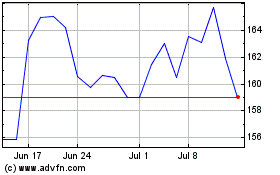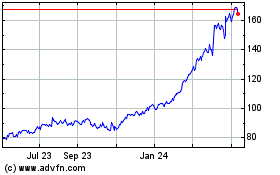Trump Administration Considers Halting GE Venture's Engine Deliveries to China -- Update
February 16 2020 - 1:44AM
Dow Jones News
By Ted Mann and Bob Davis
The Trump administration is considering a proposal to halt
deliveries of jet engines co-produced by General Electric Co. for a
new airliner being developed in China, a potential escalation of
protective trade measures that could have steep repercussions for
the major American manufacturer.
The administration may decline to issue a license allowing CFM
International, a joint venture of GE and France's Safran SA, to
export more of its LEAP 1C jet engines to China, people familiar
with the discussions said. The engines are being used in the
development of that country's Comac C919 jetliner, the latest in a
planned family of new jets that is years behind schedule.
Some within the administration are concerned that the Chinese
could reverse-engineer the CFM engines, allowing China to break
into the global jet-engine market, undermining U.S. business
interests.
People familiar with the deliberations said the primary purpose
of the push to halt the engine shipments was to cripple the
development of the Comac airliner, which China hopes to build into
a global competitor of the dominant narrow-body airliner models
made by Boeing Co. and Airbus SE. The LEAP 1C engine is the sole
engine designed for use with the new Comac C919, so interrupting
the supply of engines could produce an indefinite delay in the
production of the C919.
If put in place, the proposal wouldn't bar all engines made by
GE or its CFM joint venture from flying in China. Engines sold to
airplane makers such as Boeing or Airbus, rather than to China's
Comac, are Federal Aviation Administration certified and don't
require the license that some in the administration want to use to
hold up engines for the Comac aircraft.
GE is arguing against the move, according to a person familiar
with the talks, saying that mimicking the advanced manufacturing
techniques that have produced the engine is far harder than some
administration officials believe. As a practical matter, GE has
argued, the CFM engines have been on the ground in China for years,
meaning that Chinese manufacturers could have already begun the
reverse-engineering.
The potential denial of a new license for the engines is on the
agenda for a meeting of administration officials scheduled for
Thursday. A meeting of cabinet officials on this and other China
trade policies is scheduled for Feb. 28, the person familiar
said.
The administration is also considering whether to restrict
exports of the avionics systems GE supplies for the C919.
GE has assured investors for years that it can sell its
industrial products, which also include power turbines and medical
scanners, while protecting against piracy. The conundrum for GE and
other industrial companies: how to grab a share of the growing
market for their products in China while protecting their
intellectual property. That is especially true in the case of jet
engines, for which manufacturing processes and materials are
closely guarded secrets and development of new models costs
billions.
GE and other American aviation businesses have received
permission for years to export various systems that are being
incorporated into Chinese aircraft. As recently as March 2019, the
Commerce Department issued a license permitting CFM to ship LEAP 1C
engines to China.
The C919 is currently being flight-tested and is slated to enter
passenger service in 2021.
GE is bullish generally on the LEAP engine family, of which the
1C engine is just one variant.
"Going forward, I think we have real conviction in the LEAP
engine," GE Chief Executive Larry Culp told investors in an
earnings call in January, when the company was warning that the
delays in getting Boeing Co.'s grounded 737 MAX airliner could dent
the short-term profits from the engine.
Any interruption in deliveries could also weigh heavily on
Safran. It would likely also trigger objections from the French
government.
Write to Ted Mann at ted.mann@wsj.com and Bob Davis at
bob.davis@wsj.com
(END) Dow Jones Newswires
February 16, 2020 01:29 ET (06:29 GMT)
Copyright (c) 2020 Dow Jones & Company, Inc.
GE Aerospace (NYSE:GE)
Historical Stock Chart
From Mar 2024 to Apr 2024

GE Aerospace (NYSE:GE)
Historical Stock Chart
From Apr 2023 to Apr 2024
